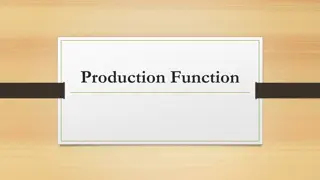Optimization of Wunderbar Production Process
Mitigating factors contributing to wunderbar-making issues, a transition to using a dipping machine, and data analysis for coating effectiveness were discussed. Experiments on different gas fills, control of coating thickness, humidity effects, and plans for future lightguide production were highlighted. Insights were shared on consistency in attenuation length, improved coating control with mechanical dip, and upcoming research directions for production enhancements at Fermilab.
Download Presentation

Please find below an Image/Link to download the presentation.
The content on the website is provided AS IS for your information and personal use only. It may not be sold, licensed, or shared on other websites without obtaining consent from the author.If you encounter any issues during the download, it is possible that the publisher has removed the file from their server.
You are allowed to download the files provided on this website for personal or commercial use, subject to the condition that they are used lawfully. All files are the property of their respective owners.
The content on the website is provided AS IS for your information and personal use only. It may not be sold, licensed, or shared on other websites without obtaining consent from the author.
E N D
Presentation Transcript
Quick Update on Wunderbars L. Bugel, J.M. Conrad, Z. Moss, J. Moon, K. Sachdev, M. Toups, T. Wongjirad March 23, 2016
When we last left this story We had mitigated a set of factors contributing to problems with wunderbar-making, but we were still making them by hand. Can we do as well or better making them with a dipping machine? Today s talk Answer: Yes.
Quick reminder: Gravity causes thicker coating at bar bottom. So we fit 2 data sets: Forward -- uncoated top is next to PMT for data taking Backward uncoated top is at far end, away from PMT Fit parameters are: attenuation length (lambda) thickness variation (C) Normalization (N) change in norm due to coated end (epsilon)
You can run this filled with dry air, nitrogen or argon (doesn t matter)
Conclusions: 1. The attenuation length is always consistent with bulk (260 cm @ 450 nm) and it has a 20% spread (maybe better control of annealing will reduce this?) 2. SNO found acrylic that had bulk attenuation length of >4 m. Would someone like to investigate how to purchase, measure and try it? 3. The coating thickness is much better controlled with the mechanical dip. Spread is <10% mechanically compared to almost 50% by hand. 4. <20% humidity in 70 F room, dipping by hand, is not vastly different from 0% humidity, mechanically dipped. 5. Building a mechanical dipping device is fun. We will spend the summer months studying these lightguides in TallBo, and making a factory at Fermilab for SBND then in Fall we will work on the DUNE lightguides.

























